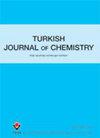同源儿茶酸双加氧酶活性位点:通过计算设计模拟次生球基
IF 1.3
4区 化学
Q3 CHEMISTRY, MULTIDISCIPLINARY
引用次数: 0
摘要
氧化环切割反应引起了人们的极大兴趣,对儿茶酚环切割酶同质原儿茶酚双加氧酶(HPCD)的各种研究已经在文献中报道。关于质子转移如何发生的现有数据使我们设计了一个潜在的HPCD模型结构。在第一个配位层上,我们小心翼翼地加入了一个次要的球效应,即对儿茶酚质子迁移到二氧至关重要的His200的辅助作用。这主要是通过修饰HPCD第一配位壳的轴向配体来实现的,从而再现了His200质子转移途径中的碱性/酸性双重作用。模型系统与单,双,和三叉戟配体报道。确定了具有合成前景的配体结构上能量可行的反应通道。概述了获得可行质子转移路径的关键结构和电子原理。本文章由计算机程序翻译,如有差异,请以英文原文为准。
Homoprotocatechuate dioxygenase active site: Imitating the secondary sphere base via computational design
Oxidative ring cleavage reactions have attracted great interest and various studies on the catechol ring-cleaving enzyme homoprotocatechuate dioxygenase (HPCD) have been reported in the literature. The available data on how the proton transfer takes place led us to design a potential HPCD model structure. A secondary sphere effect of utmost importance, the assistance of His200, which is critical for the catechol proton to migrate to dioxygen, was cautiously included on the first coordination shell. This was done mainly by modifying the axial ligands in the first coordination shell of HPCD such that the dual basic/acidic role in the proton transfer pathway of His200 was reproduced. Model systems with mono-, bi-, and tridentate ligands are reported. Energetically feasible reaction channels on synthetically promising ligand structures are identified. Key structural and electronic principles for obtaining viable proton transfer paths are outlined.
求助全文
通过发布文献求助,成功后即可免费获取论文全文。
去求助
来源期刊

Turkish Journal of Chemistry
化学-工程:化工
CiteScore
2.40
自引率
7.10%
发文量
87
审稿时长
3 months
期刊介绍:
The Turkish Journal of Chemistry is a bimonthly multidisciplinary journal published by the Scientific and Technological Research Council of Turkey (TÜBİTAK).
The journal is dedicated to dissemination of knowledge in all disciplines of chemistry (organic, inorganic, physical, polymeric, technical, theoretical and analytical chemistry) as well as research at the interface with other sciences especially in chemical engineering where molecular aspects are key to the findings.
The journal accepts English-language original manuscripts and contribution is open to researchers of all nationalities.
The journal publishes refereed original papers, reviews, letters to editor and issues devoted to special fields.
All manuscripts are peer-reviewed and electronic processing ensures accurate reproduction of text and data, plus publication times as short as possible.
 求助内容:
求助内容: 应助结果提醒方式:
应助结果提醒方式:


